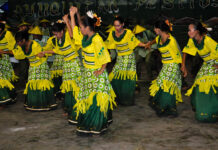
our Lady at san Roque Church in Cavite City
from wikipilipinas
Our Lady of Solitude of Porta Vaga was the title given to our Blessed Virgin Mary upon her sorrow because of the death of her beloved son Jesus.
[edit] Description
The icon is represented as the Lady in mourning. She is dressed in black and white attire. She is down on her knees as she ponders on the passion of her son. Before her are the crown of thorns and nails being used in her son’s sufferings.
[edit] Origin
In the first few days of the passion and death of her son, Mary was left alone by Jesus’ adherents as they sensed that she has a need to be alone. Widowed by her Husband Joseph and recently by her son, Mary felt the sadness of losing all the members of her family.
[edit] Founding of the Image
Jose, a young Spanish guard stationed in Porta Vaga(from vagar, meaning to wander), where residents take a leisurely walk in the evenings. One night, he caught sight of a shining object tossed ashore by the waves. He inspected it and saw that it was a painting of the Blessed Virgin Mary. He decided to take it home since no one was around to claim it.
[edit] Documented Miracles Attributed to Our Lady
Many colonizers tried to steal the Philippines from the leadership of the Spaniards. One of the assaults happened when five of the enemy vessels tried to attack two ships of the spaniards. It was prevented by the defenders when they placed the image of the Blessed Virgin Mary at the front end of one of their ships. Instantly, the tide turned in favor of the defenders.
One night, a guard at the mirador saw a woman walking at the far end of the Puerto. He called the attention of the woman twice but receive no reply. The procedure was to fire the gun after three consecutive calls. When he was about to call her attention for the last time and prepared to fire, the woman spoke and asked him if he did not recognize that it was the Blessed Virgin Mary and if so, why was he blocking her way? The guard fell on his knees and apologized for his action, explaining that he was just doing his responsibility. When he got up, the woman vanished.
In 1830, a lightning hit the wooden altar of the Cavite hermitage, causing a fire. However, the image of Our Lady remained unblemished. In 1856, a typhoon hit the entire Puerto, but the church and the patio remained dry and served as a refuge for the people affected by the flood that occured.
Susan Gonzales, an artist, was restoring an old duplicate image of the Ynang Nag-iisa in her shop. A woman came in and viewed her at work. The woman told her that after finishing the work, it would make her known. The prediction came true.
In 1857, a Spanish ship was sailing from Cavite to the coast of Albay, when they were hit by a storm. They were grounded there for almost a month. They prayed and asked for the intervention of Ynang Nag-iisa who appeared to them in their dreams. On the folowing day, the tide rose up freeing the ship from a rock entrapment.
[edit] Devotion to Our Lady
Our Lady of Solitude of Porta Vaga is one of the most venerated Marian images. Her feast is celebrated every @nd Sunday of November in Cavite City, where She is honored as the Patroness of the entire Cavite City.
Our Lady of Solitude of Porta Vaga is also associate with the Lenten rites as well as the All Saints-All Souls Day observance, where she is alluded as "Inang Magkakandila." The Image was given a Pontificial High Mass at the Binondo Church, Binondo, Manila.
In 1892, Don Juan Felipe, the Philippine National Anthem composer, composed a hymn called "Reina de Cavite." Devotion to Our Lady gave the Caviteños the opportunity to show their art skills. A replica of the Ynang Nag-Iisa is found in Buhi, Camarines Sur.
Confradia de la Virgen de la Soledad de Porta Vaga heads the devotees of Our Lady. It was established in August 1998. Devotees include overseas Filipino workers and other foreign nationals who flock the country to join the Porta Vaga Festival.
Posted by gLn98 on 2010-02-07 00:11:14
Tagged: , our , Lady , Solitude , Porta , Vaga








